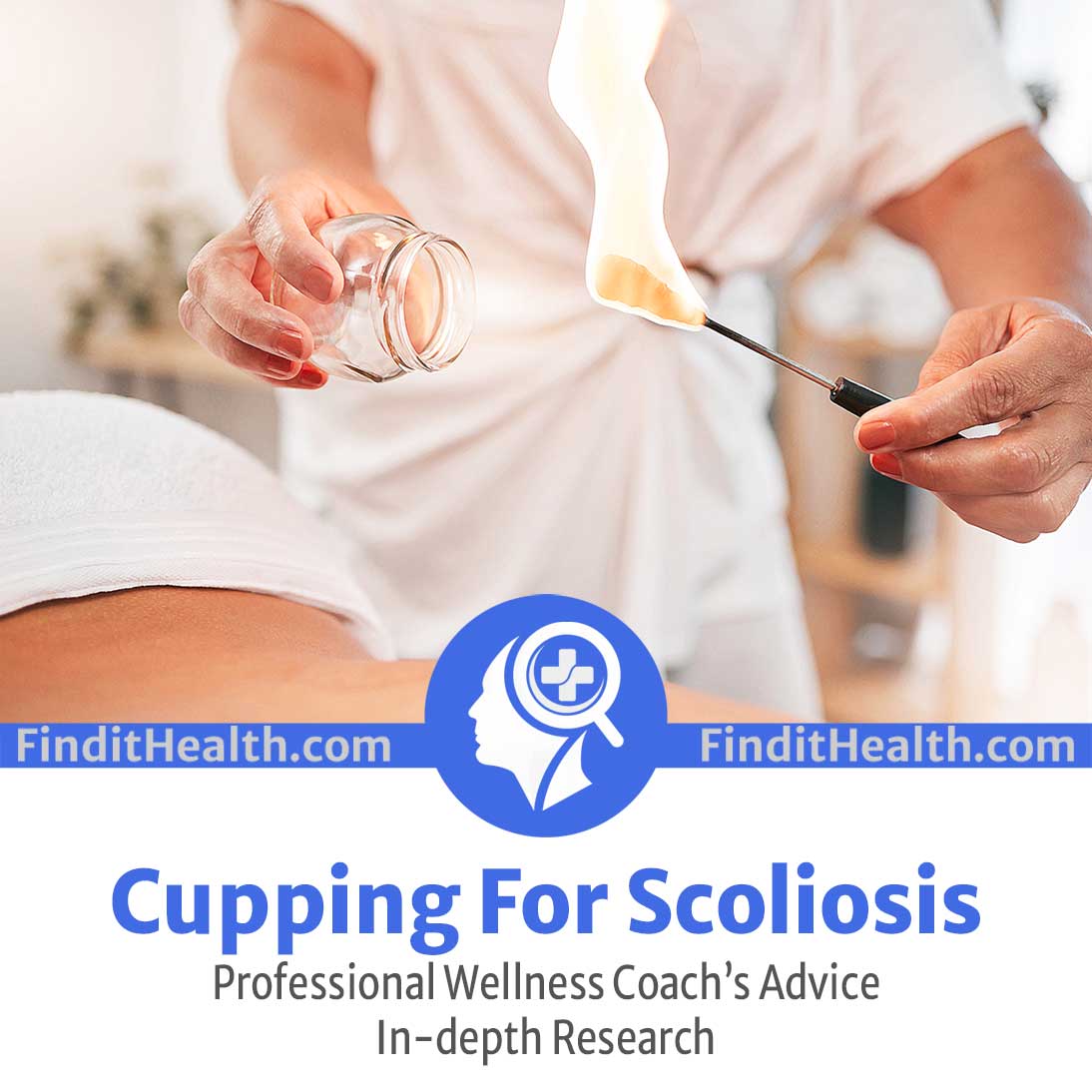
As the primary health and wellness specialist at FindItHealth, I’m here to talk about the various advantages of cupping for scoliosis.
With roots in traditional Chinese medicine, cupping is a low-risk, non-invasive alternative therapy that is useful for easing the aches and pains connected to spinal curvature. To stimulate a healing response, little cups are applied to certain body parts. Let this article be your introduction if you’re thinking about including cupping therapy in your scoliosis treatment plan. Please keep reading.
Does Cupping For Scoliosis Work?
Numerous scoliosis sufferers assert that cupping therapy is effective in easing symptoms like muscular tightness and spasms as well as decreasing chronic pain in trigger point sites.
For healing and pain release, cupping brings new blood into the painful places. A pressure valve and a pump are built within the cups to produce a light suction. Stretching the muscles and connective tissues beneath and around the cups is intended to increase blood flow to that region.
As the soft tissues are stretched, tight places could feel a slight pinch, but this discomfort usually fades away after a few minutes. Your muscles would also feel warm, stretched, and more mobile after the cups are removed.
Benefits Of Cupping For Scoliosis
Some potential advantages of cupping for scoliosis include the following:
- Reducing pain – Cupping therapy may help reduce pain associated with scoliosis by increasing blood flow to the affected area and stimulating the release of endorphins, which are natural painkillers.
- Improving flexibility – The range of motion in the spine may also be improved by cupping therapy, which is beneficial for scoliosis patients who may experience stiffness or restricted movement.
- Reducing inflammation – Cupping therapy could be beneficial for people with scoliosis who may experience inflammation in the spine or surrounding muscles.
- Relaxation – People with scoliosis who experience stress or tension from their condition may benefit from cupping therapy.
SUBSCRIBE for FREE STRESS MANAGEMENT TECHNIQUES from our EXPERT COACHES!
Scoliosis Cupping Points
The following are some typical cupping points for scoliosis:
- Bladder Meridian – Cupping along the bladder meridian, which runs along the spine, may be helpful for people with scoliosis. This meridian has several points that correspond to different areas of the spine, so the practitioner may choose specific points based on the individual’s condition.
- Governor Vessel – The Governor Vessel is a meridian that runs from the base of the spine up to the top of the head. Cupping along this meridian may help improve spinal alignment and relieve tension in the back muscles.
- Gallbladder Meridian – The Gallbladder Meridian runs along the sides of the body, and cupping along this meridian may help relieve tension in the muscles that support the spine.
- Ashi Points – Ashi points are areas of the body that are tender or painful when touched. Cupping these points may help relieve pain and tension in the muscles and improve circulation.
Frequently Asked Questions
Is cupping an effective treatment for scoliosis?
As previously stated, cupping is useful for treating scoliosis symptoms but is not a cure-all for the condition itself.
In a clinical study of a male 34-year-old US armed forces veteran who underwent acupuncture and cupping therapy, subjective pain from adult idiopathic scoliosis decreased by 85%. The patient also reported feeling more flexibility and range of motion in tight areas. The cupping therapy lasted 15 treatments before the findings were analyzed and he continued to receive treatments when his schedule allowed. The combination therapy is effective for soothing thoracic spine pain and muscle spasms but not for treating scoliosis.
Should you not do cupping for scoliosis?
Cupping for scoliosis can be beneficial but the following should be avoided during treatment:
- Cupping over bony areas – Cupping over bony areas, such as the spine or shoulder blades, can be uncomfortable and may cause bruising or other injuries. Cupping should be performed on areas with softer tissue.
- Cupping over areas with broken skin – Cupping should not be performed over areas of the skin that are broken or irritated, as this can increase the risk of infection.
- Cupping for too long – Cupping should be performed for a short period, typically around 5-10 minutes. Leaving the cups on for too long can cause discomfort or bruising.
- Cupping too frequently – Cupping should not be performed too frequently, as this can increase the risk of skin irritation or other complications. It is important to give the skin time to heal between cupping sessions.
SUBSCRIBE for FREE STRESS MANAGEMENT TECHNIQUES from our EXPERT COACHES!
Can cupping fix scoliosis?
As previously said, cupping alone, in combination of acupuncture, or with other therapies only works to treat the symptoms, not the underlying cause.
Instead, here are some of the most common solutions:
- Observation – If the scoliosis curve is mild (less than 20 degrees), the doctor may recommend regular monitoring to see if the curve progresses.
- Bracing – Bracing is often used to treat scoliosis in children and adolescents who are still growing. The goal is to prevent the curve from getting worse. The type of brace and duration of wearing will depend on the severity of the curve and the age of the patient.
- Physical therapy – Exercise and physical therapy like spinal manipulation can help strengthen the muscles, improve flexibility, and reduce pain.
- Surgery – Surgery such as spinal fusion is typically reserved for severe scoliosis cases (curves greater than 40 degrees) that are worsening or causing significant symptoms.
- Alternative therapies – Alternative therapies such as chiropractic, acupuncture, and massage may provide some relief for scoliosis symptoms, but there is limited scientific evidence to support their effectiveness.
What aggravates scoliosis?
Some factors that can make scoliosis worse include the ones listed below:
- Poor posture – Poor posture can put additional stress on the spine and exacerbate the curvature. Slouching or hunching over can worsen the symptoms of scoliosis, so it is important to maintain good posture throughout the day.
- Heavy backpacks – Carrying heavy backpacks or bags can cause the spine to twist and curve, which can worsen the curvature associated with scoliosis. It is important to carry only what is necessary and to distribute the weight evenly across the body.
- Repetitive activities – Repetitive activities that involve twisting or bending the spine, such as certain sports or manual labor jobs, can aggravate scoliosis. It is important to engage in these activities with caution and to take breaks as needed.
- Obesity – Obesity can put additional stress on the spine and exacerbate the curvature associated with scoliosis. Maintaining a healthy weight can help reduce the strain on the spine.
- Pregnancy – Pregnancy can cause changes in the spine and pelvis, which can worsen scoliosis symptoms. Women with scoliosis should speak with their healthcare provider about ways to manage their symptoms during pregnancy.
- Lack of exercise – Lack of exercise can cause the muscles supporting the spine to weaken, which can worsen the curvature associated with scoliosis. Engaging in regular exercises, such as swimming or walking, can help strengthen the muscles and reduce the strain on the spine.
SUBSCRIBE for FREE STRESS MANAGEMENT TECHNIQUES from our EXPERT COACHES!
Conclusion
The benefits of cupping therapy for scoliosis are largely anecdotal, and more research is needed to fully understand the efficacy and safety of cupping therapy for scoliosis. But as mentioned, it may be beneficial in the following:
- Pain relief
- Improving flexibility
- Reducing inflammation
- Relaxation
It is important to speak with a qualified healthcare provider to determine the proper care for scoliosis based on the individual’s specific needs and the severity of the condition. You might also be advised of medications for scoliosis to ease symptoms.
Thank you for reading this article! Please return for more advice on wellness and good health. To help you decide if cupping therapy is the best treatment for you, be sure to read our other articles about it.
SUBSCRIBE for FREE STRESS MANAGEMENT TECHNIQUES from our EXPERT COACHES!

